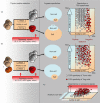The T-cell receptor repertoire of regulatory T cells
- PMID: 19128356
- PMCID: PMC2612558
- DOI: 10.1111/j.1365-2567.2008.02992.x
The T-cell receptor repertoire of regulatory T cells
Abstract
The CD4(+) CD25(+) regulatory population of T cells (Treg cells), which expresses the forkhead family transcription factor (Foxp3), is the key component of the peripheral tolerance mechanism that protects us from a variety of autoimmune diseases. Experimental evidence shows that Treg cells recognize a wide range of antigenic specificities with increased reactivity to self antigens, although the affinity of these interactions remains to be further defined. The Treg repertoire is highly diverse with a distinct set of T-cell receptors (TCRs), and yet is overlapping to some extent with the repertoire of conventional T cells (Tconv cells). The majority of Treg cells are generated in the thymus. However, the role of the TCR specificity in directing thymic precursors to become Treg or Tconv cells remains unclear. On the one hand, the higher self reactivity of Treg cells and utilization of different TCRs in Treg and Tconv repertoires suggest that in TCR interactions an initial decision is made about the 'suitability' of a developing thymocyte to become a Treg cell. On the other hand, as Treg cells can recognize a wide range of foreign antigens, have a diverse TCR repertoire, and show some degree of overlap with Tconv cells, the signals through the TCR may be complementary to the TCR-independent process that generates precursors of Treg cells. In this review, we discuss how different features of the Treg repertoire influence our understanding of Treg specificities and the role of self reactivity in the generation of this population.
Figures

Similar articles
-
Adaptation of TCR repertoires to self-peptides in regulatory and nonregulatory CD4+ T cells.J Immunol. 2007 Jun 1;178(11):7032-41. doi: 10.4049/jimmunol.178.11.7032. J Immunol. 2007. PMID: 17513752
-
A mechanism for expansion of regulatory T-cell repertoire and its role in self-tolerance.Nature. 2015 Dec 3;528(7580):132-136. doi: 10.1038/nature16141. Epub 2015 Nov 25. Nature. 2015. PMID: 26605529 Free PMC article.
-
Shaping of the autoreactive regulatory T cell repertoire by thymic cortical positive selection.J Immunol. 2007 Nov 15;179(10):6741-8. doi: 10.4049/jimmunol.179.10.6741. J Immunol. 2007. PMID: 17982064 Free PMC article.
-
Thymic commitment of regulatory T cells is a pathway of TCR-dependent selection that isolates repertoires undergoing positive or negative selection.Curr Top Microbiol Immunol. 2005;293:43-71. doi: 10.1007/3-540-27702-1_3. Curr Top Microbiol Immunol. 2005. PMID: 15981475 Review.
-
The mechanisms shaping the repertoire of CD4+ Foxp3+ regulatory T cells.Immunology. 2018 Mar;153(3):290-296. doi: 10.1111/imm.12859. Epub 2017 Nov 22. Immunology. 2018. PMID: 29106696 Free PMC article. Review.
Cited by
-
Defective dystrophic thymus determines degenerative changes in skeletal muscle.Nat Commun. 2021 Apr 8;12(1):2099. doi: 10.1038/s41467-021-22305-x. Nat Commun. 2021. PMID: 33833239 Free PMC article.
-
Infiltrating treg reprogramming in the tumor immune microenvironment and its optimization for immunotherapy.Biomark Res. 2024 Sep 4;12(1):97. doi: 10.1186/s40364-024-00630-9. Biomark Res. 2024. PMID: 39227959 Free PMC article. Review.
-
Differential regulation of Foxp3 and IL-17 expression in CD4 T helper cells by IRAK-1.J Immunol. 2009 May 1;182(9):5763-9. doi: 10.4049/jimmunol.0900124. J Immunol. 2009. PMID: 19380824 Free PMC article.
-
T cell receptor CDR3 sequence but not recognition characteristics distinguish autoreactive effector and Foxp3(+) regulatory T cells.Immunity. 2009 Dec 18;31(6):909-20. doi: 10.1016/j.immuni.2009.09.023. Epub 2009 Dec 10. Immunity. 2009. PMID: 20005134 Free PMC article.
-
A GMCSF-Neuroantigen Tolerogenic Vaccine Elicits Systemic Lymphocytosis of CD4+ CD25high FOXP3+ Regulatory T Cells in Myelin-Specific TCR Transgenic Mice Contingent Upon Low-Efficiency T Cell Antigen Receptor Recognition.Front Immunol. 2019 Jan 10;9:3119. doi: 10.3389/fimmu.2018.03119. eCollection 2018. Front Immunol. 2019. PMID: 30687323 Free PMC article.
References
-
- Hogquist KA, Baldwin TA, Jameson SC. Central tolerance: learning self-control in the thymus. Nat Rev Immunol. 2005;5:772–82. - PubMed
-
- Davis MM. T cell receptor gene diversity and selection. Annu Rev Biochem. 1990;59:475–96. - PubMed
-
- Kappler JW, Roehm N, Marrack P. T cell tolerance by clonal elimination in the thymus. Cell. 1987;49:273–80. - PubMed
-
- Kisielow P, Bluthmann H, Staerz UD, Steinmetz M, von Boehmer H. Tolerance in T-cell-receptor transgenic mice involves deletion of nonmature CD4+8+ thymocytes. Nature. 1988;333:742–6. - PubMed
-
- Stockinger B. T lymphocyte tolerance: from thymic deletion to peripheral control mechanisms. Adv Immunol. 1999;71:229–65. - PubMed
Publication types
MeSH terms
Substances
LinkOut - more resources
Full Text Sources
Other Literature Sources
Research Materials

